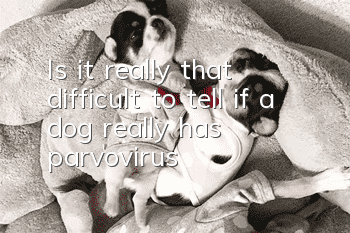Is it really that difficult to tell if a dog really has parvovirus?

Medical guidance experts are here to give you a detailed explanation. I hope it will be helpful to everyone.,,
First let’s talk about the minor clinical classifications:
1. Enteritis type (typical symptoms): depression, loss of appetite, vomiting and diarrhea, severe dehydration, weight loss, high fever, bloody diarrhea in severe cases, dark red color, and later failure, hypothermia, or incontinence of urine and feces.
2. Myocarditis: It is more common in puppies aged 28-42 days. It often has no obvious symptoms or only mild diarrhea, followed by sudden weakness, difficulty breathing, fast and weak pulse, murmur on heart auscultation, and pathological changes in electrocardiogram. Death within a short period of time.
Any disease occurs from mild to severe, so how to identify and diagnose the disease in the early stage is very critical. This is also the issue that everyone is most concerned about!
So, what are the diseases with similar symptoms to early parvovirus?
1. Cold. 2. Eat too much. 3. Food poisoning. 4. Eat human food. 5. Dirty drinking water. 6. Canine distemper. 7. Enteritis. 8. Nutritional diarrhea. 9. Parasites. 10. Coronavirus.
How can we diagnose whether a dog really has parvovirus?
1. Test version detection: There are two types of test versions: domestic and imported. Some are more sensitive and some are less sensitive. Usually when the C line is red and the T line is red, it can be judged to be small.
2. Further diagnosis: Based on routine blood tests, if the white blood cells are below 4,000, the diagnosis can be confirmed. If the white blood cells are below 2,000, it is very dangerous.
3. Clinical treatment tracking: Comprehensive judgment based on clinical treatment conditions is especially important. This is very critical.
Medical guidance tips:
1. For puppies or immunocompromised dogs under one year old, whether they test weakly positive or have insignificant symptoms, timely treatment or symptomatic treatment is crucial. We remind everyone not to delay by taking chances.
2. If the symptoms are typical, you must cooperate with the doctor for comprehensive systemic treatment, including infusion, injection of antiviral biological products, enhanced care, etc.
3. Usually the treatment period is about a week, and there may be a peak period in 3-5 days. After passing through, most of them will have a good prognosis and will have little impact on future growth and development.
4. If hypothermia, exhaustion, coma, incontinence, etc. occur clinically, the possibility of cure is usually extremely low. Whether to continue treatment requires a comprehensive evaluation by pet owners and doctors!
- What documents and conditions are needed to open a pet hospital?
- Nursing care for dogs during their recovery period
- Symptoms of canine distemper
- What is the personality of the Akita dog?
- Here’s everything you want to know about pet parasites!
- Owners need to make these preparations before a female dog gives birth
- What are the symptoms of Samoyed canine distemper?
- How to prevent hepatitis in dogs
- Why does the Welsh Terrier have red spots on its body?
- What are the symptoms of dog stones?



